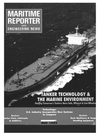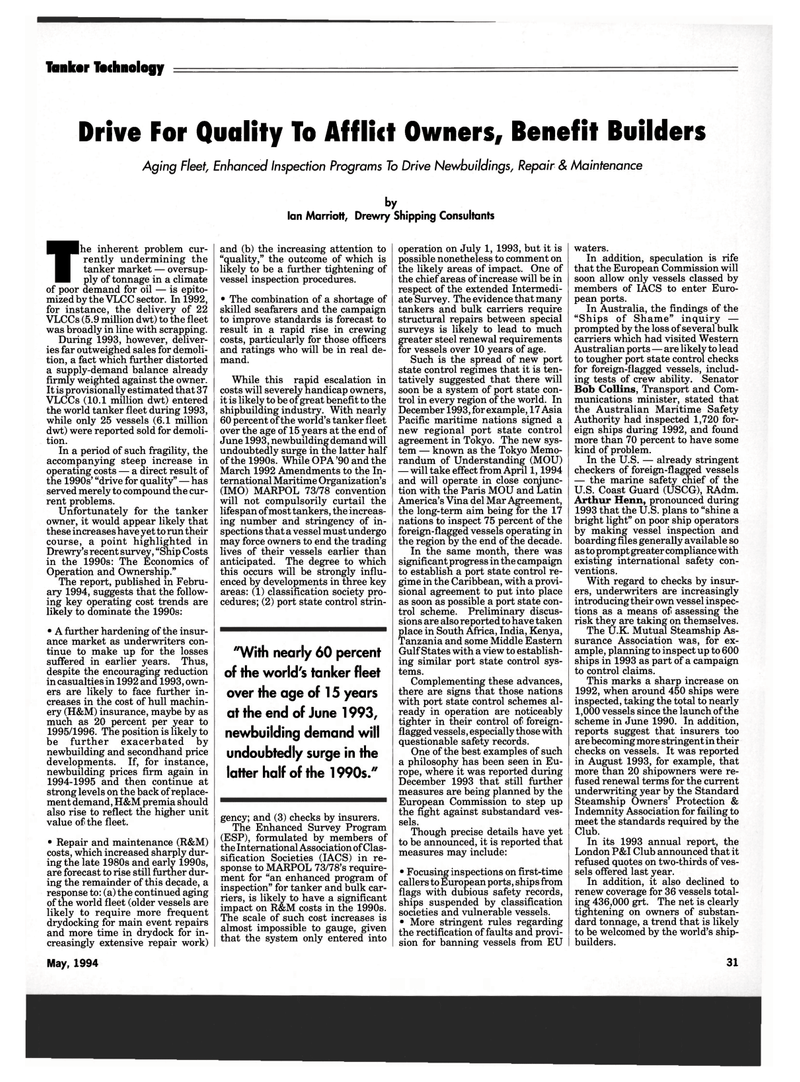
Page 29: of Maritime Reporter Magazine (May 1994)
Read this page in Pdf, Flash or Html5 edition of May 1994 Maritime Reporter Magazine
Tanker Technology
Drive For Quality To Afflict Owners, Benefit Builders
Aging Fleet, Enhanced Inspection Programs To Drive Newbuildings, Repair & Maintenance by
Ian Marriott, Drewry Shipping Consultants
The inherent problem cur-rently undermining the tanker market — oversup-ply of tonnage in a climate of poor demand for oil — is epito- mized by the VLCC sector. In 1992, for instance, the delivery of 22
VLCCs (5.9 million dwt) to the fleet was broadly in line with scrapping.
During 1993, however, deliver- ies far outweighed sales for demoli- tion, a fact which further distorted a supply-demand balance already firmly weighted against the owner.
It is provisionally estimated that 37
VLCCs (10.1 million dwt) entered the world tanker fleet during 1993, while only 25 vessels (6.1 million dwt) were reported sold for demoli- tion.
In a period of such fragility, the accompanying steep increase in operating costs — a direct result of the 1990s' "drive for quality" — has served merely to compound the cur- rent problems.
Unfortunately for the tanker owner, it would appear likely that these increases have yet to run their course, a point highlighted in
Drewry's recent survey, "Ship Costs in the 1990s: The Economics of
Operation and Ownership."
The report, published in Febru- ary 1994, suggests that the follow- ing key operating cost trends are likely to dominate the 1990s: • A further hardening of the insur- ance market as underwriters con- tinue to make up for the losses suffered in earlier years. Thus, despite the encouraging reduction in casualties in 1992 and 1993, own- ers are likely to face further in- creases in the cost of hull machin- ery (H&M) insurance, maybe by as much as 20 percent per year to 1995/1996. The position is likely to be further exacerbated by newbuilding and secondhand price developments. If, for instance, newbuilding prices firm again in 1994-1995 and then continue at strong levels on the back of replace- ment demand, H&M premia should also rise to reflect the higher unit value of the fleet. • Repair and maintenance (R&M) costs, which increased sharply dur- ing the late 1980s and early 1990s, are forecast to rise still further dur- ing the remainder of this decade, a response to: (a) the continued aging of the world fleet (older vessels are likely to require more frequent drydocking for main event repairs and more time in drydock for in- creasingly extensive repair work) and (b) the increasing attention to "quality," the outcome of which is likely to be a further tightening of vessel inspection procedures. • The combination of a shortage of skilled seafarers and the campaign to improve standards is forecast to result in a rapid rise in crewing costs, particularly for those officers and ratings who will be in real de- mand.
While this rapid escalation in costs will severely handicap owners, it is likely to be of great benefit to the shipbuilding industry. With nearly 60 percent of the world's tanker fleet over the age of 15 years at the end of
June 1993, newbuilding demand will undoubtedly surge in the latter half of the 1990s. While OPA '90 and the
March 1992 Amendments to the In- ternational Maritime Organization's (IMO) MARPOL 73/78 convention will not compulsorily curtail the lifespan of most tankers, the increas- ing number and stringency of in- spections that a vessel must undergo may force owners to end the trading lives of their vessels earlier than anticipated. The degree to which this occurs will be strongly influ- enced by developments in three key areas: (1) classification society pro- cedures; (2) port state control strin- "With nearly 60 percent of the world's tanker fleet over the age of 15 years at the end of June 1993, newbuilding demand will undoubtedly surge in the latter half of the 1990s." gency; and (3) checks by insurers.
The Enhanced Survey Program (ESP), formulated by members of the International Association of Clas- sification Societies (IACS) in re- sponse to MARPOL 73/78's require- ment for "an enhanced program of inspection" for tanker and bulk car- riers, is likely to have a significant impact on R&M costs in the 1990s.
The scale of such cost increases is almost impossible to gauge, given that the system only entered into operation on July 1, 1993, but it is possible nonetheless to comment on the likely areas of impact. One of the chief areas of increase will be in respect of the extended Intermedi- ate Survey. The evidence that many tankers and bulk carriers require structural repairs between special surveys is likely to lead to much greater steel renewal requirements for vessels over 10 years of age.
Such is the spread of new port state control regimes that it is ten- tatively suggested that there will soon be a system of port state con- trol in every region of the world. In
December 1993, for example, 17 Asia
Pacific maritime nations signed a new regional port state control agreement in Tokyo. The new sys- tem — known as the Tokyo Memo- randum of Understanding (MOU) — will take effect from April 1,1994 and will operate in close conjunc- tion with the Paris MOU and Latin
America's Vina del Mar Agreement, the long-term aim being for the 17 nations to inspect 75 percent of the foreign-flagged vessels operating in the region by the end of the decade.
In the same month, there was significant progress in the campaign to establish a port state control re- gime in the Caribbean, with a provi- sional agreement to put into place as soon as possible a port state con- trol scheme. Preliminary discus- sions are also reported to have taken place in South Africa, India, Kenya,
Tanzania and some Middle Eastern
Gulf States with a view to establish- ing similar port state control sys- tems.
Complementing these advances, there are signs that those nations with port state control schemes al- ready in operation are noticeably tighter in their control of foreign- flagged vessels, especially those with questionable safety records.
One of the best examples of such a philosophy has been seen in Eu- rope, where it was reported during
December 1993 that still further measures are being planned by the
European Commission to step up the fight against substandard ves- sels.
Though precise details have yet to be announced, it is reported that measures may include: • Focusing inspections on first-time callers to European ports, ships from flags with dubious safety records, ships suspended by classification societies and vulnerable vessels. • More stringent rules regarding the rectification of faults and provi- sion for banning vessels from EU waters.
In addition, speculation is rife that the European Commission will soon allow only vessels classed by members of IACS to enter Euro- pean ports.
In Australia, the findings of the "Ships of Shame" inquiry — prompted by the loss of several bulk carriers which had visited Western
Australian ports—are likely to lead to tougher port state control checks for foreign-flagged vessels, includ- ing tests of crew ability. Senator
Bob Collins, Transport and Com- munications minister, stated that the Australian Maritime Safety
Authority had inspected 1,720 for- eign ships during 1992, and found more than 70 percent to have some kind of problem.
In the U.S. — already stringent checkers of foreign-flagged vessels — the marine safety chief of the
U.S. Coast Guard (USCG), RAdm.
Arthur Henn, pronounced during 1993 that the U.S. plans to "shine a bright light" on poor ship operators by making vessel inspection and boarding files generally available so as to prompt greater compliance with existing international safety con- ventions.
With regard to checks by insur- ers, underwriters are increasingly introducing their own vessel inspec- tions as a means of assessing the risk they are taking on themselves.
The U.K. Mutual Steamship As- surance Association was, for ex- ample, planning to inspect up to 600 ships in 1993 as part of a campaign to control claims.
This marks a sharp increase on 1992, when around 450 ships were inspected, taking the total to nearly 1,000 vessels since the launch of the scheme in June 1990. In addition, reports suggest that insurers too are becoming more stringent in their checks on vessels. It was reported in August 1993, for example, that more than 20 shipowners were re- fused renewal terms for the current underwriting year by the Standard
Steamship Owners' Protection &
Indemnity Association for failing to meet the standards required by the
Club.
In its 1993 annual report, the
London P&I Club announced that it refused quotes on two-thirds of ves- sels offered last year.
In addition, it also declined to renew coverage for 36 vessels total- ing 436,000 grt. The net is clearly tightening on owners of substan- dard tonnage, a trend that is likely to be welcomed by the world's ship- builders.
May, 1994 31

 28
28

 30
30
